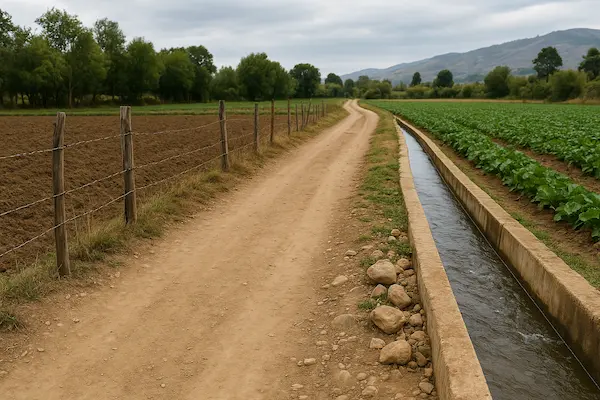DIFFERENCE BETWEEN APPARENT AND NON-APPARENT EASEMENTS IN BOLIVIA

This distinction is critical because only apparent easements can be acquired by the owner’s designation or through acquisitive prescription. Non-apparent easements require an explicit legal act to be valid.
EASEMENTS BY OWNER’S DESIGNATION IN REAL ESTATE TRANSACTIONS
When a person owns two adjoining properties and there is a visible sign of easement between them — such as a water channel crossing both plots — and later sells one of the properties without making any mention of the easement, Bolivian law presumes the easement remains in place, either as a benefit or a burden, depending on the case.
This legal presumption allows the new owner of the transferred plot to continue the established use, provided it aligns with the nature of an easement. The rule prevents the loss of a pre-existing right due to contractual silence and protects usage rights visibly established between the properties.
ACQUISITIVE PRESCRIPTION OF EASEMENTS
Acquisitive prescription allows the acquisition of real rights through long-term, peaceful, and uninterrupted use. In the case of apparent easements, if someone has continuously and publicly used a path, channel, or other visible form of easement across another person’s property for the legally required period, they may claim a right to that easement.
For example, if a community has used a clearly marked road on private land for over ten years to access its agricultural plots, and has done so without interruption or formal permission, a legal right to the easement may be recognized through acquisitive prescription.
This mechanism grants legal protection to long-standing factual relationships, converting them into enforceable rights, provided all legal conditions — including timeframes — are met under Bolivian law.
WHEN ACQUISITIVE PRESCRIPTION DOES NOT APPLY TO EASEMENTS
Bolivian law specifies that non-apparent easements cannot be acquired either by the owner’s designation or by acquisitive prescription. If no visible signs indicate the existence of an easement, it cannot be presumed nor consolidated through use alone. In such cases, an express agreement between parties or a judicial resolution is required for the easement to be legally constituted.
In summary, Bolivian law outlines clear criteria for recognizing an easement without a written agreement. The existence of visible signs and prolonged use are essential conditions for the recognition of easements through owner’s designation or acquisitive prescription. However, the exclusion of non-apparent easements from these mechanisms emphasizes the importance of physical evidence or formal documentation in establishing real rights over property.
If you are dealing with a matter related to easements, our law firm offers expert legal advice on property rights, including the establishment, regulation, or termination of easements. Contact us today for specialized legal assistance.
Frequently Asked Questions (FAQs)
What is the difference between an apparent and a non-apparent easement?
An apparent easement has visible indicators like roads, channels, or cables, while a non-apparent easement leaves no external evidence.
Can I acquire an easement without a written contract?
Yes. If the easement is apparent, it can be acquired through the owner’s designation or acquisitive prescription, provided legal conditions are met.
What happens if I sell a property with a visible easement and don’t mention it in the contract?
The law presumes the easement remains in effect for or against the sold property if there are visible signs.
How long does it take to acquire an easement through acquisitive prescription?
The same period applies as for property acquisition through usucapión, generally ten years under Bolivian law.
Can non-apparent easements be acquired through long-term use?
No. Non-apparent easements require an express agreement and cannot be acquired through usage or by the owner’s designation.
The content of this article does not reflect the technical opinion of Rigoberto Paredes & Associates and should not be considered a substitute for legal advice. The information presented herein corresponds to the date of publication and may be outdated at the time of reading. Rigoberto Paredes & Associates assumes no responsibility for keeping the information in this article up to date, as legal regulations may change over time.


